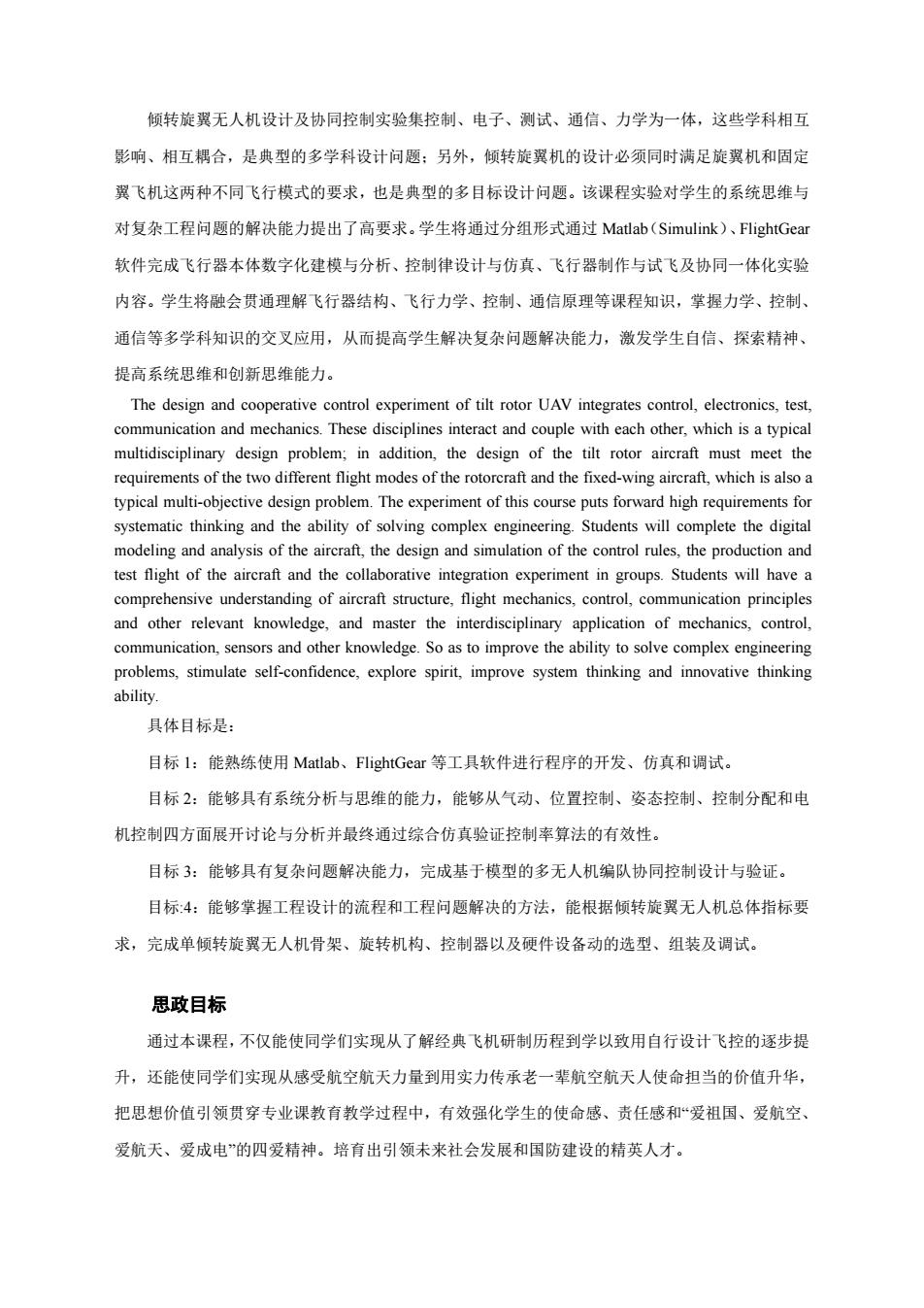正在加载图片...

倾转旋翼无人机设计及协同控制实验集控制、电子、测试、通信、力学为一体,这些学科相互 影响、相互耦合,是典型的多学科设计问题:另外,倾转旋翼机的设计必须同时满足旋翼机和固定 翼飞机这两种不同飞行模式的要求,也是典型的多目标设计问题。该课程实验对学生的系统思维与 对复杂工程问题的解决能力提出了高要求。学生将通过分组形式通过Matlab(Simulink)、FlightGear 软件完成飞行器本体数字化建模与分析、控制律设计与仿真、飞行器制作与试飞及协同一体化实验 内容。学生将融会贯通理解飞行器结构、飞行力学、控制、通信原理等课程知识,掌握力学、控制、 通信等多学科知识的交叉应用,从而提高学生解决复杂问题解决能力,激发学生自信、探索精神、 提高系统思维和创新思维能力。 The design and cooperative control experiment of tilt rotor UAV integrates control,electronics,test, communication and mechanics.These disciplines interact and couple with each other,which is a typical multidisciplinary design problem;in addition,the design of the tilt rotor aircraft must meet the requirements of the two different flight modes of the rotorcraft and the fixed-wing aircraft,which is also a typical multi-objective design problem.The experiment of this course puts forward high requirements for systematic thinking and the ability of solving complex engineering.Students will complete the digital modeling and analysis of the aircraft,the design and simulation of the control rules,the production and test flight of the aircraft and the collaborative integration experiment in groups.Students will have a comprehensive understanding of aircraft structure.flight mechanics.control,communication principles and other relevant knowledge,and master the interdisciplinary application of mechanics,control, communication,sensors and other knowledge.So as to improve the ability to solve complex engineering problems,stimulate self-confidence,explore spirit,improve system thinking and innovative thinking ability. 具体目标是: 目标l:能熟练使用Matlab、FlightGear等工具软件进行程序的开发、仿真和调试。 目标2:能够具有系统分析与思维的能力,能够从气动、位置控制、姿态控制、控制分配和电 机控制四方面展开讨论与分析并最终通过综合仿真验证控制率算法的有效性。 目标3:能够具有复杂问题解决能力,完成基于模型的多无人机编队协同控制设计与验证。 目标:4:能够掌握工程设计的流程和工程问题解决的方法,能根据倾转旋翼无人机总体指标要 求,完成单倾转旋翼无人机骨架、旋转机构、控制器以及硬件设备动的选型、组装及调试。 思政目标 通过本课程,不仅能使同学们实现从了解经典飞机研制历程到学以致用自行设计飞控的逐步提 升,还能使同学们实现从感受航空航天力量到用实力传承老一辈航空航天人使命担当的价值升华, 把思想价值引领贯穿专业课教育教学过程中,有效强化学生的使命感、责任感和“爱祖国、爱航空、 爱航天、爱成电”的四爱精神。培育出引领未来社会发展和国防建设的精英人才。倾转旋翼无人机设计及协同控制实验集控制、电子、测试、通信、力学为一体,这些学科相互 影响、相互耦合,是典型的多学科设计问题;另外,倾转旋翼机的设计必须同时满足旋翼机和固定 翼飞机这两种不同飞行模式的要求,也是典型的多目标设计问题。该课程实验对学生的系统思维与 对复杂工程问题的解决能力提出了高要求。学生将通过分组形式通过 Matlab(Simulink)、FlightGear 软件完成飞行器本体数字化建模与分析、控制律设计与仿真、飞行器制作与试飞及协同一体化实验 内容。学生将融会贯通理解飞行器结构、飞行力学、控制、通信原理等课程知识,掌握力学、控制、 通信等多学科知识的交叉应用,从而提高学生解决复杂问题解决能力,激发学生自信、探索精神、 提高系统思维和创新思维能力。 The design and cooperative control experiment of tilt rotor UAV integrates control, electronics, test, communication and mechanics. These disciplines interact and couple with each other, which is a typical multidisciplinary design problem; in addition, the design of the tilt rotor aircraft must meet the requirements of the two different flight modes of the rotorcraft and the fixed-wing aircraft, which is also a typical multi-objective design problem. The experiment of this course puts forward high requirements for systematic thinking and the ability of solving complex engineering. Students will complete the digital modeling and analysis of the aircraft, the design and simulation of the control rules, the production and test flight of the aircraft and the collaborative integration experiment in groups. Students will have a comprehensive understanding of aircraft structure, flight mechanics, control, communication principles and other relevant knowledge, and master the interdisciplinary application of mechanics, control, communication, sensors and other knowledge. So as to improve the ability to solve complex engineering problems, stimulate self-confidence, explore spirit, improve system thinking and innovative thinking ability. 具体目标是: 目标 1:能熟练使用 Matlab、FlightGear 等工具软件进行程序的开发、仿真和调试。 目标 2:能够具有系统分析与思维的能力,能够从气动、位置控制、姿态控制、控制分配和电 机控制四方面展开讨论与分析并最终通过综合仿真验证控制率算法的有效性。 目标 3:能够具有复杂问题解决能力,完成基于模型的多无人机编队协同控制设计与验证。 目标:4:能够掌握工程设计的流程和工程问题解决的方法,能根据倾转旋翼无人机总体指标要 求,完成单倾转旋翼无人机骨架、旋转机构、控制器以及硬件设备动的选型、组装及调试。 思政目标 通过本课程,不仅能使同学们实现从了解经典飞机研制历程到学以致用自行设计飞控的逐步提 升,还能使同学们实现从感受航空航天力量到用实力传承老一辈航空航天人使命担当的价值升华, 把思想价值引领贯穿专业课教育教学过程中,有效强化学生的使命感、责任感和“爱祖国、爱航空、 爱航天、爱成电”的四爱精神。培育出引领未来社会发展和国防建设的精英人才